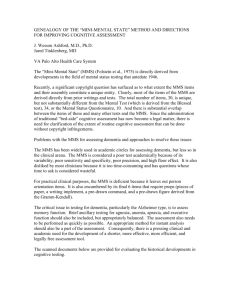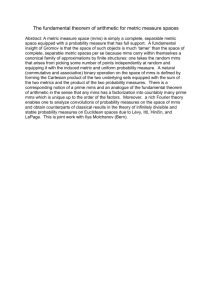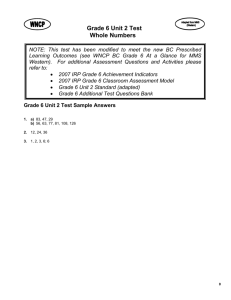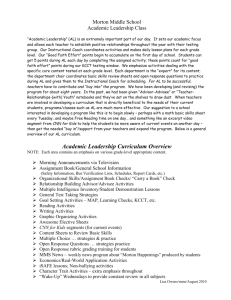Papers
advertisement
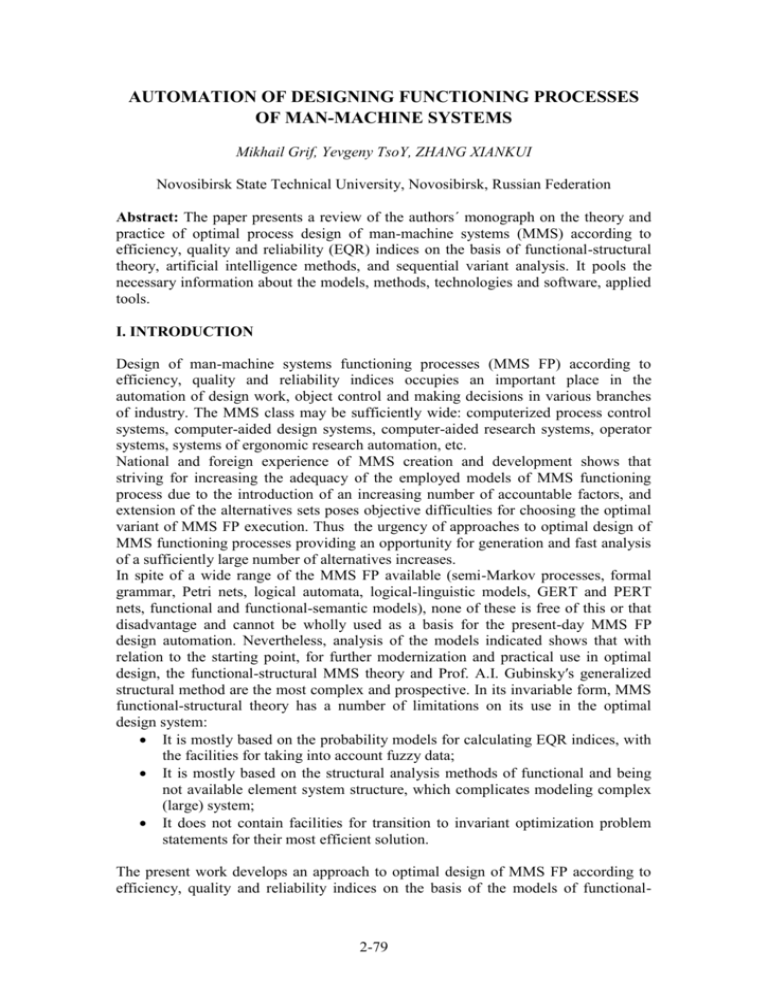
AUTOMATION OF DESIGNING FUNCTIONING PROCESSES OF MAN-MACHINE SYSTEMS Mikhail Grif, Yevgeny TsoY, ZHANG XIANKUI Novosibirsk State Technical University, Novosibirsk, Russian Federation Abstract: The paper presents a review of the authors´ monograph on the theory and practice of optimal process design of man-machine systems (MMS) according to efficiency, quality and reliability (EQR) indices on the basis of functional-structural theory, artificial intelligence methods, and sequential variant analysis. It pools the necessary information about the models, methods, technologies and software, applied tools. I. INTRODUCTION Design of man-machine systems functioning processes (MMS FP) according to efficiency, quality and reliability indices occupies an important place in the automation of design work, object control and making decisions in various branches of industry. The MMS class may be sufficiently wide: computerized process control systems, computer-aided design systems, computer-aided research systems, operator systems, systems of ergonomic research automation, etc. National and foreign experience of MMS creation and development shows that striving for increasing the adequacy of the employed models of MMS functioning process due to the introduction of an increasing number of accountable factors, and extension of the alternatives sets poses objective difficulties for choosing the optimal variant of MMS FP execution. Thus the urgency of approaches to optimal design of MMS functioning processes providing an opportunity for generation and fast analysis of a sufficiently large number of alternatives increases. In spite of a wide range of the MMS FP available (semi-Markov processes, formal grammar, Petri nets, logical automata, logical-linguistic models, GERT and PERT nets, functional and functional-semantic models), none of these is free of this or that disadvantage and cannot be wholly used as a basis for the present-day MMS FP design automation. Nevertheless, analysis of the models indicated shows that with relation to the starting point, for further modernization and practical use in optimal design, the functional-structural MMS theory and Prof. A.I. Gubinsky′s generalized structural method are the most complex and prospective. In its invariable form, MMS functional-structural theory has a number of limitations on its use in the optimal design system: It is mostly based on the probability models for calculating EQR indices, with the facilities for taking into account fuzzy data; It is mostly based on the structural analysis methods of functional and being not available element system structure, which complicates modeling complex (large) system; It does not contain facilities for transition to invariant optimization problem statements for their most efficient solution. The present work develops an approach to optimal design of MMS FP according to efficiency, quality and reliability indices on the basis of the models of functional- 2-79 structural theory, artificial intelligence and sequential variant analysis methods which should lift the above restrictions. The monograph is written on the basis of the authors′ original research. It contains seven chapter. II. PROBLEM STATEMENT Chapter 1 of the monograph considers the major models, methods and technologies for optimal MMS FP design according to probability and fuzzy indices of efficiency, quality and reliability. Comparison of basic methods and models and recommendations for their efficient use are given. The MMS functioning process is understood as a logic-time sequence of actions and operations of the ergatic and non-ergatic system elements resistant towards disturbances and leading to achieving the goal (or goals) of functioning [1]. MMS FP runs in inter-connected spaces: MMS elements E , executed functions F , MMS states S , the occurring events W and MMS indices Q . The MMS FP optimization problem statement is of the following form: К EQR ( А) extr, (1) A Md where A is the variant of MMS FP execution; К EQR ( А) the optimality critetion for the EQR criteria combination; M d a set of admissible alternatives. As the EQR criteria, the probability of correct (error free) execution B(A) , mean time T (A) and average expenses (profit) V (A) resulting from the execution, the probability of timely ~ realization of P( t Td ) , fuzzy probability of correct realization of B( A) , fuzzy ~ ~ expenses (profit) V ( A) and realization time T ( A) are applied. III. SET OF ALTERNATIVES CONSTRUCTION Chapter 2 describes the methods of MMS FP optimization model representation on the basis of functional and functional-semantic net work with the application of MMS element sets, executed functions and operations. Estimates of alternatives set power, structural and object oriented design strategies as well as a method for obtaining a unified knowledge base of MMS FP in the production-logical form are given. The operation O O( F , E, S , MW , Q) MТФЕ is understood as a process of function F performance by the element E in the state of MMS s. As a result, some antithetical events W MW can take place. Probable or (and) fuzzy indices EQR Q(W ) fO ( F , E, П E , S ) are connected with each event W . As a “simple” operation, there used standard functional units (SFU), “working operation” (WO), and two SFU of condition testing: testing the performance correctness of the operation controlled (“functional control” (FC)) and testing the equipment efficiency and (or) human being’s ability to work (“diagnostic control” (DC)). While performing WO SFU A , two events are probable: W A1 as correct realization and W A0 as non-correct. Realization of FC (DC) SFU involves four events: W11(W10 ) is the recognition of the condition tested as true (false) with its actual truth; W01 (W00 ) the recognition of the condition tested as true (false) with its actual falsity. Fuzzy EQR indices, for instance, for 2-80 ~ ~ ~ working operation A : B( A),T ( A) and V ( A) have the membership function ~ ( B( A)), ~ (T ( A)) and V~ (V ( A)) , correspondingly, where B( A) [ B( A), B ( A)], B T T ( A) [T ( A), T ( A)], V ( A) [V ( A), V ( A)] . One of the most wide-spread forms of fuzzy ~ ~ ~ values representation is used, namely, expansion of B( A),T ( A) and V ( A) into levels: ~ ~ ~ B ( A) [ B ( A), B ( A)] ; T ( A) [V ( A), V ( A)] . [T ( A), T ( A)] ; V ( A) [0,1] [0,1] [0,1] The set of principal standard functional structures (SFS) M SFS contains 12 structures [2]. Each SFS as an algorithmic structure is a binary relation of control transfer to the set of operators (SO) and conditions (FC, DC). It is also possible to specify the i -th SFS and equivalent to this SFUO O as n - local relation O SFSi (Oi , Oi ,...) , where the equivalent SFU (ESFU) O is called a compound 1 2 operation. The compound operation can be only of WO type. To calculate the ESFU indices, the previously derived formulas the arguments of which are SFU containing SFS are used. The separate the MMS functioning process (functional network (FN)) is rerepresented as a SFS superposition [2]: Oz SFS i (Oi , Oi ,..., Oi ) , 1 2 (2) k where SFSi М SFS , Oi j is a simple or compound operation. The simple operation (the final one) does not have an equivalent SFS, and the compound one is specified by analogy with (2) – Oi SFS s (Os , Os ,..., Os ) , SFS s М SFS , where the operations j Os1 , Os2 ,..., Osk 1 2 k , in its turn, are either simple or compound. Let us say that the two operations with the same function: F - O( F , E1, Q1 ) and O( F , E2 , Q2 ) are alternative (“parametric”) ways of fulfilling operations O , as well as OТФСs ( Os1 , Os2 ,...) , i s are “structural" ones. The sources of forming parametric alternatives SFU and FN are, on the whole, alternative values of simple elements parameters (MMS element structure objects); alternative relations for composite elements; alternative assignments of elements to simple operations. The alternatives set can be specified graphically by means of alternative graph (AG) [2]. The generation algorithm (calculation of EQR) of FN Oz in (2) starts with the most embedded compound operations Ok ТФСs ( Os1 , Os2 ,...) and extends to the top level Oz ТФСi ( Oi1 , Oi2 ,...) . In structured programming, three strategies of program development are singled out. These are bottom-up, top-down and mixed ones. Since the generalized-structured method [1], lying in the basis of AG, to a significant degree relies on analogical to the structured programming paradigms, namely SFU, SFS, the “convolution” of SFS to the equivalent to them SFI, FN analysis and synthesis, then when AG is being formed, all the three above mentioned strategies can be applied. Let us note the disadvantages of the structured strategy. As a result of bottom-up and top-down design procedures, only one invariant form of MA assignment M ( Az ) M inv ( Az ) is generated; duplication of element structure description with the assignments of MMS similar elements to different operations; tight binding of implementation techniques to the specific fragments; difficulties connected with the organization of situation control of the FN alternatives set structure; weak standardization of FN fragments. The object-oriented model of description and quantitative estimates of MMS FP indices (object-oriented 2-81 functional network) is constructed by way of synthesis of functional-structured theory, object-oriented design, fuzzy sets and methods (models) of artificial intelligence [2]. The basis of this model is the object-oriented method of FP specifying, the elements of which are classes, objects, relations (of inheritance, filling, metaclass, application), properties, methods, etc.. Within the framework of this technique, the description of the set of alternatives and its modification methods is made. In [2], one-to-one correspondence between the description of MMS FP alternatives sets for the FN models (functional-semantic models (FSM)) and production-logical knowledge base in the form of the Prolog language is defined. In [2], a Prolog-program generating AS taking into account the feasible of variants implementing the generation algorithm is presented. IV. THE SEQUENTIAL OPTIMIZATION METHOD Chapter 3 presents the research results of probability and fuzzy MMS indices in order to reveal the monotone recursiveness properties. The above properties are further applied to constructing optimization algorithms. Chapter 4 considers the method of MMS FP sequential optimization for the functional net work model within the general scheme of sequential variant analysis method. The necessary and sufficient condition of optimality and feasibility of partial solutions are formulated and proved, the estimates of power and labour requirements for generation of a set of non-dominating alternatives are obtained, the efficiency of various schemes for approximated optimization algorithms is investigated. Chapter 5 describes the choice of optimal algorithm for directed exhaustive search by way of solution to a problem of the given algorithm labour requirements minimization. A method of solution to the above problem (strategy) related to the invariant transformation of the alternatives sets: change in the partial solutions generation sequence, simplification of the necessary optimality conditions for the particular case of the sets of alternatives and limitations, cancellation of certain check on the necessary optimality conditions are proposed and theoretically substantiated. The problem of parallelizing the algorithm for directed exhaustive search consisting in the solution of the initial optimization problem on several computers is considered. The structure of the Prolog-program implementing the developed method of sequential MMS FP optimization directly on the production-logical knowledge base by way of the inference procedure is described. In [2], a sequential optimization method for the MMS FP on the basis of SF model within the framework of general scheme of variants’ sequential analysis method with the stepwise construction of partial solutions has been developed. A specific algorithm of stepwise construction is determined by the choice rule of partial solutions (subnets) , subject to development at each step, and a test kit , carrying out the sifting of those which can’t be completed to the optimal ones. Variation of parameters and leads to various algorithms of the sequential variants analysis method applied to the MMS FP optimization problems for the functional net works. The rules of sifting the unpromising partial solutions are based on the property of monotone recursiveness of probable and fuzzy indices and depend on the type of problem (1). The estimation of non-dominated (by Pareto) alternatives power (partial solutions) is made for the particular case of truncated (without optimal alternative choice) algorithm for directed search (ADS). The working time is interpreted as mean time (the number of machine operations) required for the optimization problem solution. As a result of numerical modeling, the ADS working time estimate has been 2-82 obtained. Also, the working time estimate for verifying the necessary conditions of partial solutions feasibility as well as the necessary conditions of optimality according to the efficiency function has been derived. In [3] the description and results of comparative analysis of approximate methods efficiency for the problem solution (1) : a sequential genetic algorithm and scheme with additional compression of partial solutions in ADS, where the advantage of the latter according to accuracy and deriving the solution is shown, is presented. In [3] the problem of choosing the optimal ADS as a problem of the given algorithm working time minimization is stated. Methods for solution to the problem indicated (strategy) connected with the invariant transformations of the set of alternatives (alternative graph) [2]: changing the partial solutions generation sequence, simplification of the necessary optimality conditions (NOC) for the SA partial cases and constraints, cancellation of some verifications of the NOC themselves are suggested and theoretically substantiated. The ADS paralleling problem is considered, which consists in solving the initial optimization problems on several computers in case when it is impossible to obtain the solution on one computer during the feasible time. The variant selection criterion of computers distribution among operators of generation and “sifting” partial solutions with the availability of spare computers the meaning of which consists in the maximal use of spare (available) computers has been introduced. On the basis of this criterion, a general scheme for parallel ADS implementation has been suggested. The Prolog-program structure implementing the method of MMS FP sequential optimization including ADS optimization strategy directly with the production-logical knowledge base by means of the inference mechanism is described [2]. V. MMS FP DESIGN TECHNOLOGY Chapter 6 considers the MMS FP design technologies and software. Elements of structural and object-oriented approach as well as detailed description of hybrid expert design system MMS FP INTELLECT-2 are given. Chapter 7 reviews typical examples of practical application of the developed software for the MMS FP optimal design problems. In [2] a conception, the major principles and elements of the MMS functioning processes design technology according to the EQR probable and fuzzy indices have been formulated. The basis of the technology is an object-oriented and structural approach to the MMS FP design, the sequential optimization method and productionlogical knowledge base covering all aspects of the design environment. The design technology indicated has been implemented most completely in the form of hybrid expert system INTELLECT-2 functioning on the IBM PC-type computer in the operational environment Win32, programming languages C++ Builder and Visual Prolog and offering the user the following opportunities (Fig 1): to specify MMS FP sets of alternatives the form of alternative graph with the application of structural and (or) object-oriented technologies; form directories of MMS elements, functions and SFU used in an object-oriented form; to turn on the arbitrary production-logical knowledge base in the form of Prolog-program and translate the optimization model as well as any of its components in the Prolog-program; to determine the optimality criterions and constraints of the optimization problems on the basis of probable or fuzzy indices; to make the estimation of power and working time of obtaining the efficient solutions for all the SFU of the alternative graph; to choose the optimal algorithm of directed search; to specify the control parameters for the optimization algorithm; to control the process of optimization problem solution; to select the set of 2-83 effective solutions to the arbitrary SF in AG; to represent the design results and then store them in the archived file. Fig. 1. Hybrid expert system INTELLECT-2. CONCLUSIONS The models and methods of the MMS FP optimal design considered in the present monograph do not completely meet the needs of the MMS designers. The authors think that the long-term problems for further investigation which could become the topics of dissertation research are as follows: 1. Integration of factor and process MMS optimization models. 2. Developing joint-use technologies for simulation and optimization models. 3. Formulation of optimization problems with the application of linguistic variables (terms). 4. Taking into account the figures of merit and types of defects in the MMS FP models when accomplishing an operations. 5. Developing parallel schemes for optimization algorithms. REFERENCES Gubinsky A.I., Reliability and Quality of Ergatic Systems Functioning – Leningrad: Nauka, 1982. (In Russian) [2] Grif M.G., Tsoi Ye.B., Implementation of the Method of Sequential Variant Analysis with Complex Systems Optimization according to Fuzzy and Probable Indices //Siberian Journal of Industrial Mathematics, 2001, Volume IV. No № 2(8). PP. 123-141. (In Russian) [3] Grif M.G., The Choice of Effective Algorithm of Sequential Man-Machine Systems Optimization //Papers of Siberian Division of Higher School Academy of Sciences, № 2 (4). PP. 53-59. (In Russain) [4] Grif M.G., Tsoi Ye.B. Automation of Designing of Functioning Processes of ManMachine Systems based on the Method of Sequential Optimization. – Novosibirsk, NGTU: Publishing house , 2005. - 262 p. (In Russian) [1] 2-84
